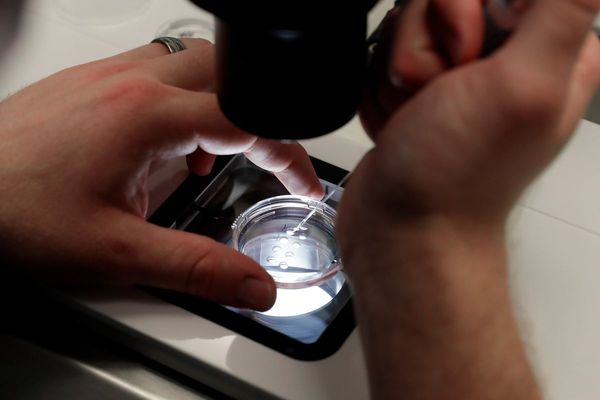
Autodesk is a Business Reporter client.
An entirely new wave of automation is now taking root in the design and manufacturing industry—and for good reasons. Finding skilled labor remains a challenge, margins are becoming increasingly smaller, speed to market is imperative to success, and the supply chain and consumer demand remain in flux. But what problems can automation help manufacturers address? How can busy companies even start to leverage new technology without becoming overwhelmed?
Kelvin Hamilton, Senior Innovation Manager at Autodesk, leads a team of engineers that looks at the future of manufacturing. His team strategizes how manufacturers can solve industry-wide problems by leveraging emerging technologies and automations through the lens of Autodesk’s cloud-based product development solution, Autodesk Fusion.
Working at Autodesk on one of the largest Design and Make Platforms gives Hamilton a broad perspective and the ability to have an industry-wide impact. “If I can work on and solve some of the pervasive problems facing Autodesk customers, those concepts and solutions could potentially touch millions of people in the end,” he says.
Here, Hamilton shares insights into manufacturer’s key pain points, how leveraging technology can help solve them, and how businesses should approach exploring automation solutions.
What does your team focus on, and what sets your work apart?
My team works directly with Autodesk’s design and manufacturing customers to understand what they want to achieve and what problems they are trying to solve. We create definitions and concepts to make sure we are all speaking the same language and prototype solutions that address those problems using many different problem-solving techniques, including automation.
We’re in a unique position having the time and ability to research, explore, and uncover innovative solutions for these businesses within a nimble team. We work with the wider development organization and share learnings and insights to ensure we are creating the best solutions.
As a team, we spend most of our time in the discomfort of the ‘problem-space’ where we discover, define, clarify, understand and strategize before moving to the more familiar ‘solution-space.’ We heavily use divergent-convergent thinking in our work to make sure we are looking at both problem and solution from various perspectives. Above all, the mission of Autodesk is to make a better world designed and made for all, and that is the ethos behind how we approach our work.
Much of your work is focused on automation specific to the design and manufacturing industry. Can you break down what automation means in this context?
Automation is a massive term that means something different to everyone. It’s typically about alleviating the burdens of intervention/choice/expertise from a human repeating the same repetitive actions or tasks so that they can focus on more important and meaningful work, which creates a value add for them and their businesses.
Automation tools can support both the design and manufacturing side of product development. Let’s use the ubiquitous mobile phone as an example. Before making it into your hands, companies involved in the design process create rough concepts, iterate through many design variations, and then communicate their intent, designs and requirements to other stakeholders. To facilitate this collaboration, they use visualization and 3D modeling or CAD software, which helps unify, speed up, and automate the design process for ever expansive and global teams.
CNC machines are programmed by CAM software, which automates the machine’s movements based on a set of instructions defined by the operator.
Over to the manufacturing side, the millions of phone bodies produced each year are usually molded from plastics within metal mold cavities or milled directly from solid pieces of metal. These hard materials require precise cutting and shaping with specialized machines to remove excess material. But how do you get the machines to do what is required? They are programmed using computer automated machining (CAM) software which automates the creation of machine movements and the generation of machine instructions during manufacture.
And those are just a few broad examples. There are many smaller automations that take place within product development cycles, including in the factory environment (think manufacturing robots).
Can you name three industry pain points that you notice coming up often across companies and how automation can address them?
The first is standardization, which can be within a team, a company, or even an industry. If you ask five people to perform the same task, they might use five different approaches, ultimately reaching five different outcomes. This can result in quality disparities since each applies their own way of working and biases. Defining a set of procedures, frameworks, and expectations is the precursor of automation. To start the automation journey, you must first organize your house and define your procedures and processes upfront. Otherwise, you’re subject to product disparities and inefficiencies.
Another big one is upskilling and knowledge transfer. As the working population continues to age and companies look to scale their capacity quickly, transferring knowledge is already a bottleneck. How do you share individual/organizational knowledge and make it accessible to others? You take it out, create procedures and define repeatable best practices, keep it somewhere (like a database or CAD/CAM tool), and show others how to use it. Automation can be leveraged as a mechanism to retrieve and share the necessary information and knowledge in an organized and repeatable way.
CAD/CAM tools like Autodesk Fusion help businesses standardize procedures to consistently achieve high-quality product design outcomes.
And finally, there’s speed to market. If you want to get your products or solutions to market in a short amount of time, as most businesses do, implementing automation during product development is a realistic way to maximize resources and output. This could be by leveraging concept/design automations as well as manufacturing and factory level automation tools.
What advice do you have for businesses who are interested in exploring automation as a solution to their own similar challenges?
Start by considering overall business goals and challenges instead of fixating on the automation itself. Asking questions like “What do teams struggle with most in their day-to-day jobs?” reaches a level where you can get more fundamental to your business and begin to understand tangible pain points and pervasive problems you’re facing. Then seek solutions and partners to resolve them.
To survive in today’s fast-paced competitive landscape, businesses need to adopt technologies and solutions that help their business and employees thrive. We find that early adopters are already saying yes to automation because they recognize the core problems they have and how automation could solve them, making it more natural to take that first step.
Technology is advancing rapidly. If you want to stay ahead of the curve, my advice is to establish a core team or person dedicated to researching new ways to improve the way you work and flagging any potential obstacles ahead of time. And if you don’t have time or people, you may be able to align with a trusted partner, like Autodesk, who can do some of the heavy lifting for you.
If you don’t create the opportunity to develop a longer-term perspective on your business and its relation to the industry at large, cracks are going to surface when it’s too late or when you don’t even realize it.
Fortunately, there are solutions that are helping to make this transition easier. Autodesk’s vision for the Fusion Industry Cloud for Manufacturing integrates Fusion’s capabilities, Autodesk AI, and a robust network of industry partners. It connects capabilities, data, people, and processes across the entire product development lifecycle to share information to better approach challenges.
With all the hype currently around AI, how do you envision it being leveraged as part of the automation conversation?
It is true that AI, and more specifically, Machine Learning, has entered into the general vocabulary recently. Autodesk has teams that have spent years researching and crafting a vision and mission as well as experimenting with how industries can leverage this tech within its products.
At a high level, AI and machine learning are tools and techniques in our toolbox that we can use to help and improve the way we problem solve, automate repetitive tasks, and create solutions to persistent problems. For example, how can AI save a company countless hours by helping them create technical drawings to send to overseas manufacturers? How can AI be leveraged to automate the design of non-critical components or to create multiple iterations to help with trade-off decisions?
Like automation, before businesses leverage AI and machine learning as tools, they must understand the problems they want to solve and get familiar with the technologies. Without that base-level organization, it becomes difficult to know if the solutions are solving the right problems or even if the results you receive make sense at all.
Where does Autodesk come into wider design and manufacturing industry conversation about automation?
Autodesk’s deeply rooted history in the design and manufacturing industries as well as the trust our customers put in us by making our software solutions mission-critical for their businesses gives us a unique voice. We’ve already acted as a trusted partner to many of our customers as they transitioned from 2D to 3D or desktop to cloud. The advent of accelerated automation, radical global collaboration, and artificial intelligence will not be any different.
The first step to automation is standardization. Enabling teams to collaborate with a common software tool that brings people, processes and data from different disciplines together is the ultimate dream. With Autodesk Fusion, tools for 3D modeling, simulation, machining, electronics design and data management are all in the same environment on the cloud. This centralized approach allows teams to share, communicate, and connect, which helps remove inefficiencies and friction.
Fusion is the first of its kind in the design and manufacturing industries, and I’m excited to see how it continues to influence the future of product development.







